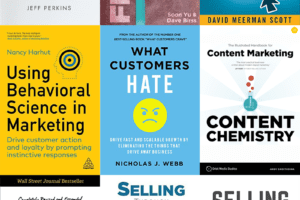???? Episode 86 of Yes, and Marketing
Nick Schrunk has been creating and capturing extreme stunts and adventures for Red Bull for over a decade, including promos for brands like Porsche and athletes like Olympian Lindsey Vonn. He also won an Emmy Award as director of the film Blood Road, which documented mountain biker Rebecca Rush’s journey through the jungles of southeast Asia in an effort to track down the story of her father in the Vietnam War.
To say he knows how to tell a story and capture an audience is an understatement.
In this episode, Nick and Steve cover storytelling, stunts, the creative process, and more:
- A few of the insane stunts he’s helped to create
- The biggest indicator of a successful process
- The two types of content
- How too many approvals can ruin a project
- His ultimate metric for identifying successful content
Tap through the chapters above to listen or read on for our highlights of the conversation.
???? Who is Nick Schrunk?
Name: Nick Schrunk
What he does: Action and adventure cinematographer, producer, and creative director. Emmy Award-winning director of Blood Road.
Find Nick on the web: Website | Instagram | LinkedIn
Get smart: “When you’re actually creating something that is unique or offers something to the audience so much that they want to adopt it as their own and share it because they feel that it helps them— that is the ultimate metric of successful content.”
???? Yes, and… Action Cinematography
Give your audience a seat on the roller coaster
“You’re really selling this experience and idea, and you’re giving them a seat on the roller coaster.”
That’s the power of content, says Nick. For his work on Red Bull projects, whether it’s creating a commercial for Porsche or filming an athletic stunt, his goal is to share that experience with the audience in a way that removes all boundaries.
“You’re giving this view into this world and this lifestyle and you’re encouraging your audience to want to participate, to imagine themselves doing that,” he explains. “The more barriers you can remove between them and what they’re watching, the more intense that is.”
What story can your brand tell that your audience will want to be a part of? What experience can you share, and how can you share it in a way that enables them to imagine themselves in it?
Nick adds, “Whether it’s a car company, whether it’s a lifestyle brand, whether it’s an action sports brand or whether it’s a brand that has nothing to do with that, the idea of putting someone in that seat of the roller coaster—that’s the core of what you want to do.”
???? Episode Highlights
Read verbatim excerpts from our interview with director Nick Schrunk.
What drew him to Red Bull
“It was this dramatic, new idea—an energy drink. They were the first, and they established this category. Their marketing was world-class because it was the first time people had done this idea of marketing action and adventure sports, and it was the perfect combination of message and product.
Here’s a product that enables body and mind, that enables you to live life to the fullest. And then here’s the strategy of taking these lifestyles and building stories around them and telling stories through photo and video in a way that allowed people to experience this.”
Streamline your process
“The faster you can work, the less layers for approval that you have, and the more singular your creative team—of both approval, execution, and ultimately who publish it—the more you can streamline that, generally speaking, the more successful you can become.”
The changing speed of content
“Back in the old days—let’s just say a decade ago, before content marketing was really here—teams could more or less think of big moments in the calendar a year in advance, build a story around it, come up with a plan of, are we shooting a commercial? Are we shooting a short story with it? And bring it to market.
Something like that would take about six months, with lots of approvers in a traditional way. Now, with the speed that everyone’s consuming media, it just means that ideas are used, recycled, and brought to market a lot faster.”
Shorten your timeline
“If you’re able to build out your plan in a way that you can take an idea and have it posted to social, or have it put online, or run through and put into production within a number of days instead of a number of weeks, that is in my opinion the most indicative part of the system that’s going to lead to success.
The rest of it is just variables: How do you tell a good story? What’s interesting, and how does it talk to your audience? You just layer those on top.”
Video literacy takes more than eyeballs
“There’s this whole idea of video literacy: If you have a set of eyeballs, you’re going to have an opinion of something you’re watching. Whether or not you can train yourself to see, ‘What is the message contained within that? And how does that speak to our audience? Am I offering some type of currency with this content, or am I just filling the air?’
It takes a while to break the idea of, ‘Just because I can see something, I can build an opinion’ to actually see something through the lens of all of the goals that a company or an organization or a person might have.”
The trap of approvals
“You can get caught up in a very long system of approvals that, by the end of it, perhaps you’ve rubbed all of the interesting bits off of it. You’ve shaved down the corners, but then it doesn’t excite anybody. There’s no negative in it.”
The two types of content
- Giving an idea: “Is this something that is going to inform someone? Offer them some social currency, offer them a skill or a knowledge or an idea that they didn’t have before? An instance of that is what we’re doing right now. Your audience is listening to capture ideas and adopt them into their process.”
- Sharing an experience: “You’re giving this view into this world and this lifestyle and you’re encouraging—at least in good content—you’re encouraging your audience to want to participate and imagine themselves doing that.”
Mass rejection of copycat content
“What I think a lot of us are experiencing right now is this ‘content apocalypse’ where so many brands—and not in a bad way—are essentially following trends. They’re copying each other and they’re doing it because it’s such an important tool, and it is so hard to come up with unique content.
There’s a lot of copycatting happening. And I think audiences, as we all advance, are actively rejecting that.”
The ultimate metric of successful content
“If you offer something that gives them social currency—that if someone shares this, they’re going to feel like it belongs. They’re going to feel like they’re in the club and they’re offering something to their friends—that is the most rewarding thing as a content marketer that you can achieve.
…The same reason that commentators on NFL or an NBA game or why people watch Sports Center, it’s because they’re adopting those ideas themselves so when they go to the water cooler the next day, they’re able to talk as this authority. And in content marketing, when you’re actually creating something that is unique or offers something to the audience so much that they want to adopt it as their own and share it because they feel that it helps them—that is the ultimate goal, and that is the ultimate metric of what I think leads to successful content.”
????️ Nick Schrunk Quotes
“Storytelling: If you can combine that with the spectacle of either action or adventure, that’s the next level stuff that is really memorable.”
“If you want to be competitive, you need to streamline your approach.”
“When I’m watching something, I’m projecting myself into the shoes of who I’m watching, and the more barriers that you can remove between that, the more intense that is.”
“I always like to establish, ‘What are we offering our audience here?’ Because if you’re not offering them anything, then you should stop talking about the idea.”
“Whatever your brand voice or the type of content that you do, you want to find a way that when you do more of it, you’re able to take those ideas and scale them to larger things.”
“The more continuity you can find amongst things, the better, and the more the audience will reward that because they know what they’re signing up for.”
???? Learn More
- Check out Blood Road, the Emmy Award-winning documentary Nick directed.
- Learn more about Jimmy Chin, another action director whose work Nick admires.
- See behind the scenes of one of Nick’s projects with Porsche: Drive2Extremes.



